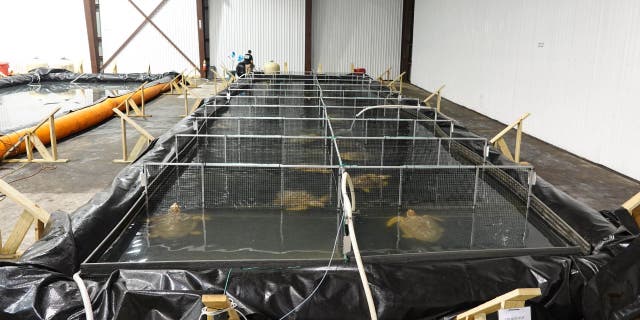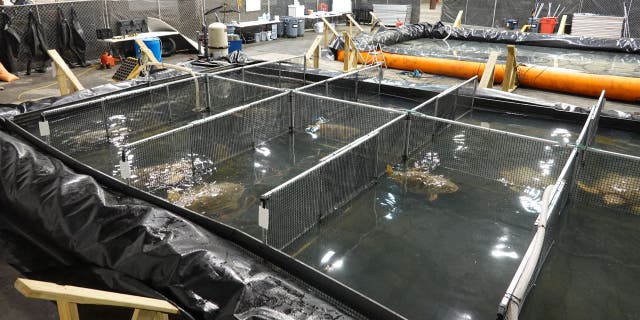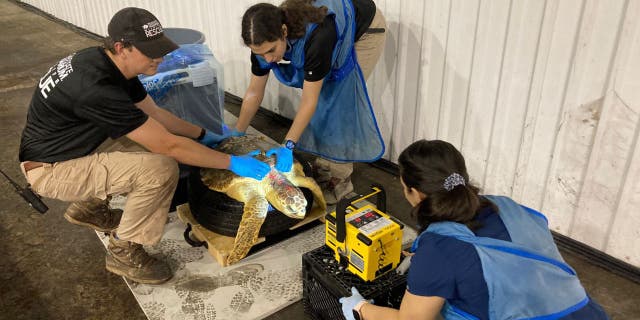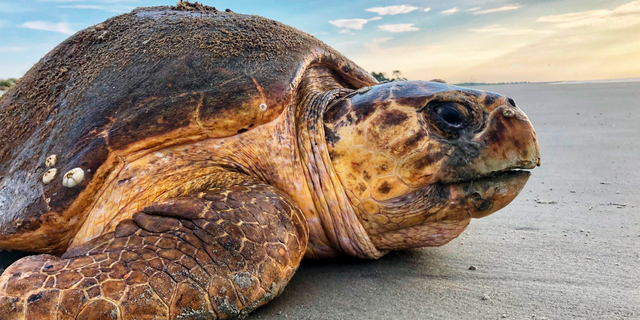The Texas State Aquarium is rushing to save thousands of loggerhead sea turtles that continue to wash up along a nearly 50-mile stretch of the south Texas coastline along the Gulf of Mexico.
Jesse Gilbert, the aquarium’s president and CEO, said last week that many loggerhead sea turtles started stranding themselves in the Corpus Christi area at the beginning of summer, and nobody was sure why.
Texas State Aquarium crews set up a rehabilitation facility in Port Corpus Christi, Texas to help stranded loggerhead turtles recover before being sent back into the wild.
(Texas State Aquarium)
Though loggerheads are not endangered, they are listed under the Endangered Species Act as threatened. So, when a bunch of turtles begin to beach themselves, the federal government gets heavily involved in looking into the issue.
GULF COAST SEA TURTLES APPEAR TO BE RECOVERING
Scientists at the aquarium noticed the turtles were coming in underweight and dehydrated, suggesting that they were having a food consumption issue.
Gilbert said the aquarium’s wildlife rescue program has helped to rehabilitate cold-stunned turtles for several years, and at one point, there were 1,500 turtles in their facility during cold weather.
When that happened, he said, they developed a plan to be able to recover 3,000 turtles at a time.

Texas State Aquarium crews reverse-engineered a system originally used to keep rising waters away from structures during hurricanes, to now keep water in and give turtles a space to recover.
(Texas State Aquarium)
The stranding of loggerhead turtles is a different situation, and at 200 pounds each, they are much bigger than the turtles they have saved in the past.
SEA TURTLES ON FLORIDA’S SPACE COAST ON TRACK TO SET NEW RECORD FOR NESTS
Still, the federal government approached the aquarium in the middle of the summer and asked them to get involved by activating an emergency contingency plan.
The problem was that the loggerheads kept stranding themselves in the summer, taking longer to recover.
Gilbert said it was starting to look like the loggerheads were going to be in recovery when winter hit, not leaving much space for the cold-stunned turtles that typically get stranded in the colder months.
“It was a really challenging event,” he said. “Now we were getting to the point that we were going to have to keep all of these turtles during the winter.”

Texas State Aquarium crews quickly acquired a warehouse in Port Corpus Christi, Texas, to set up spaces for loggerhead turtles to recover after getting stranded on the beach.
(Texas State Aquarium)
In early August, the feds asked Gilbert and his team to enact all the emergency systems and all the contingency plans to recover as many turtles as they could.
15 SEA TURTLES RESCUED AFTER HURRICANE IAN RELEASED INTO FLORIDA KEYS
“It’s unprecedented in the history of the aquarium and our wildlife rescue program to activate everything we have in order to accommodate these animals,” he said.
Part of the plan involved calling partners at the Port of Corpus Christi to find a suitable area to stage rescue efforts.
A new rescue center is being constructed next to the Port of Corpus Christi; it is not due to open until March 2023.

Texas State Aquarium crews quickly acquired a warehouse in Port Corpus Christi, Texas, to set up spaces for loggerhead turtles to recover after getting stranded on the beach.
(Texas State Aquarium)
“The turtles kind of beat us to the punch,” Gilbert said.
While looking for a facility, two criteria needed to be met. First, the facility needed to be a big warehouse that could protect the turtles from the northern winds during the winter, and second, it needed to be close to natural seawater.
FLORIDA ZOO CARES FOR HUNDREDS OF BABY SEA TURTLES IN WAKE OF HURRICANE IAN
Gilbert explained that Corpus Christi Bay is healthy, and being within a close proximity, crews can pump the water into makeshift tanks inside the warehouse.
These tanks are pretty much large booms that prevent water from leaking out.
In February 2021, an estimated 30,000 turtles were stranded during Winter Storm Yuri.

Newly hatched Kemp’s ridley sea turtle makes its way out to the Gulf of Mexico from Louisiana’s Chandeleur Islands.
(Louisiana Coastal Protection & Restoration Authority)
The Texas State Aquarium was able to rescue about 1,500 turtles that were stranded during the event, enabling leaders to throw out a challenge to save 3,000 turtles in a system that could also be used to recover dolphins, manatees, and other large sea animals.
FLORIDA DEPUTIES RESCUE ‘LOST’ SEA TURTLE HATCHLINGS WANDERING HOTEL GROUNDS
Later that year, members of the team were watching hurricane coverage and saw one homeowner use a flood control device that was wrapped around his home, keeping floodwaters from penetrating the structure.
The scientists and engineers at the aquarium found a way to reverse engineer the device with the idea that if it can keep water out, it must be able to keep water in.
And it worked.

In this July 5, 2019, photo provided by the Georgia Department of Natural Resources, a loggerhead sea turtle returns to the ocean after nesting on Ossabaw Island, Ga. The giant, federally protected turtles are having an egg-laying boom on beaches in Georgia, South Carolina and North Carolina, where scientists have counted record numbers of nests this summer. (Georgia Department of Natural Resources via AP)
“We were able to erect these systems, and they’re in place now,” Gilbert said of the warehouse and everything inside. He also said there were already turtles recovering in the new facility. “Because of this port building, we are going to be able to recover these animals and get this endangered species back out into the wild.”
SCIENTISTS FIND ‘REAL LIFE’ PATRICK AND SPONGEBOB IN OCEAN EXPEDITION
Corpus Christi is one of the summer grounds for loggerhead turtles.
These large cold-blooded animals take thermal cues and migrate to warmer waters where they prey on crabs, fish, shrimp, sea urchins, and other proteins.
Why they are stranding on this 50-mile stretch of beach and nowhere else along the Gulf of Mexico remains a mystery to scientists, as they try to determine what is being missed from the animals’ diet.
CLICK HERE TO GET THE FOX NEWS APP
Until they figure that out, the aquarium is prepared to help as many of those turtles survive as possible.
“It’s been a heroic event,” Gilbert said. “It’s probably from a rescue standpoint, one of the most challenging, logistical things we’ve done, but it’s worked. We’re excited to get these animals recovered and get them out of here as soon as possible.”